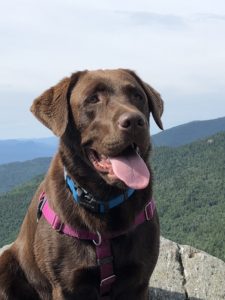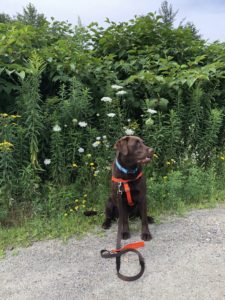 I love to hike and explore in Vermont and New Hampshire with my Chocolate Lab, Sophie. Our day hikes take us from meandering, wooded brook-side trails to rock face and astonishing summit views. Sophie, not quite 2, loves these adventures and is responsible for my new passion – hiking.
I love to hike and explore in Vermont and New Hampshire with my Chocolate Lab, Sophie. Our day hikes take us from meandering, wooded brook-side trails to rock face and astonishing summit views. Sophie, not quite 2, loves these adventures and is responsible for my new passion – hiking.
True confession: I am afraid of bears. Yes, I know, I know. Most likely most bears are far more afraid of me – or at least far more reluctant to encounter me than I am to encounter them. But that doesn’t change the way I feel. Hey, there are rogue people, aren’t they? I’m sure there are rogue bears out there in the woods. And more significantly, there are bears in the woods who might be surprised to see me show up or, far worse, a mama bear who might jump to the defense of her baby bear(s).
 Perhaps what is significant here is that I know there ARE bears in the woods and on the trails. How do I know this? No, I have not met one – yet. I have seen a bear on my husband’s game camera set up on a trail I use frequently. I have stepped over bear scat and I have read blog posts, seen tv news reports, stopped to read signs posted at State Park entrances, and heard anecdotal accounts of bear sightings, often corroborated by cell phone pics.
Perhaps what is significant here is that I know there ARE bears in the woods and on the trails. How do I know this? No, I have not met one – yet. I have seen a bear on my husband’s game camera set up on a trail I use frequently. I have stepped over bear scat and I have read blog posts, seen tv news reports, stopped to read signs posted at State Park entrances, and heard anecdotal accounts of bear sightings, often corroborated by cell phone pics.
Moreover, it seems that the bear population is on the rise here in Vermont. We know this for a number of reasons and because wildlife officials are seeing a rise in the number of calls about incidents with black bears.
Most often bear activity is related to campsites and food. Guidelines and warnings about camping, food handling and storage, discarding garbage and Leave No Trace are easy to follow and involve a healthy dose of common sense.
 For those of us who hike with dogs, there is an extra layer of prevention and protection for which we, the human companions, need take responsibility. I would hope that my dog would sense the presence of a bear long before I would and would alert me. I would fervently hope that my dog would not notice cubs and, thinking they are other pups to be greeted and played with, go do so. (Labs are oh so friendly with other dogs, aren’t they?). Disaster would ensue.
For those of us who hike with dogs, there is an extra layer of prevention and protection for which we, the human companions, need take responsibility. I would hope that my dog would sense the presence of a bear long before I would and would alert me. I would fervently hope that my dog would not notice cubs and, thinking they are other pups to be greeted and played with, go do so. (Labs are oh so friendly with other dogs, aren’t they?). Disaster would ensue.
So, here’s what I do. I carry a leash in my hand if Sophie is off leash and, if I see her go on the alert or look skittish about anything, I call her back and snap on the leash until I know the coast is clear. Of course, things could get out of hand quickly but this is a start.
If I am anywhere near a campground or picnic area, I keep her leashed – especially if I am near the dumpsters. (Leashing your dog is often posted in this type of area anyway.) Following the advice of a friend, I have ordered a bear bell for Sophie to wear and may put another on my pack as well. On the other hand, I keep up a running conversation with my girl anyway, so I’m sure we give warning!
Here, as is often the case, awareness is the best policy. Though it may be tempting to zone out on a remote trail, perhaps it’s best not to.
Shared below are some words of advice from Vermont’s Green Mountain Club as well as a helpful link to yet more tips. Hike on!
 WILDLIFE – Green Mountian Club August 2, 2018 Black Bears–Bears have become more active around Long Trail campsites and trails in the last few years. In areas with posted bear warnings, please follow a few basic steps:
WILDLIFE – Green Mountian Club August 2, 2018 Black Bears–Bears have become more active around Long Trail campsites and trails in the last few years. In areas with posted bear warnings, please follow a few basic steps:
- Keep dogs leashed.
- Do not feed or approach bears.
- If you encounter a bear, make noise* and back away slowly. Do not run.
Another GMC post says this: Bears are becoming more numerous and more active. Though usually shy and unaggressive, bears that have sampled human food can become dangerous, putting their lives at risk. Help bears stay safe: If you encounter a bear, stay calm, keep eye contact, talk to the bear in a conversational voice*, and back away slowly. Do not run. Do not feed or approach bears. Report bear encounters to the GMC.
(Note: there does seem to be a discrepancy about making noise or a conversational voice, but it is agreed not to turn and run.) It is also important to consider other wildlife… MOOSE – Moose tracks and droppings can be seen throughout the trail. While moose look similar to deer, they can be extremely dangerous when irritated. If you see a moose on the trail, do not approach it. Wait for the moose to move on before continuing. They are particularly territorial in the fall during mating season. Their eyesight is very bad so the recommended strategy if a moose charges you is to try to put a large tree between you and the moose, remove your pack and make human noises.
And the link: https://www.ripitenergy.com/beware-bear-10-safety-tips/
